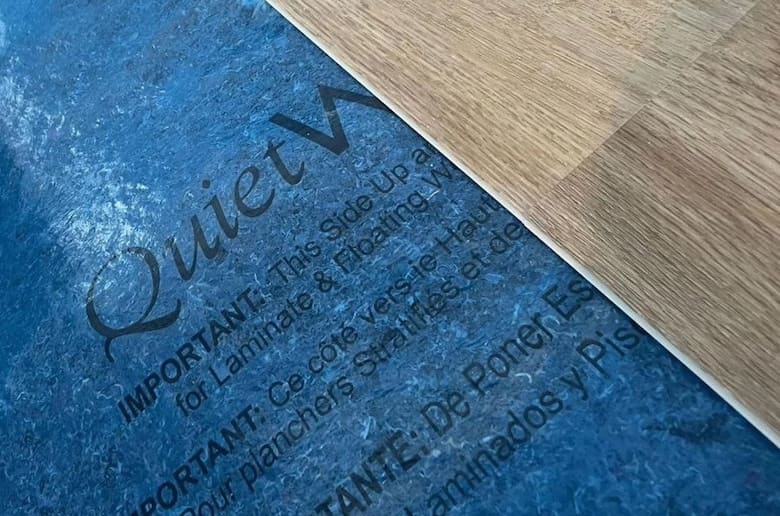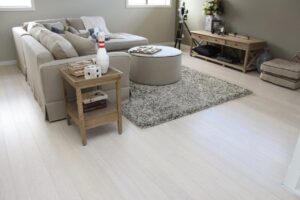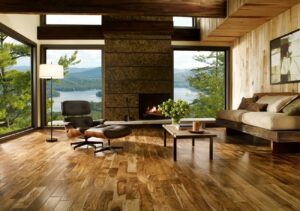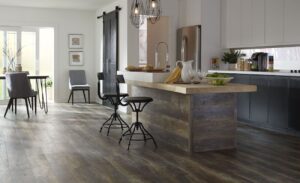The quest for a serene indoor ambiance often leads us to scrutinize sound reduction in flooring, where products like Floor Muffler vs Quiet Walk take center stage.
Yet, beneath the surface, the composition of underlayment is equally pivotal, dictating not only acoustic benefits but also the longevity of your floors. Moreover, the intricacies of airflow and moisture protection cannot be overstated; the right choice wards off potential damage from below.
And let’s not overlook thickness and density—silent guardians that uphold the integrity and feel of our cherished hardwood or laminate.
These layers, often unseen, form the bedrock of a home’s tranquility and structural harmony.
Quick Comparison Between Floor Muffler and Quiet Walk
| Feature | Floor Muffler | Quiet Walk |
|---|---|---|
| Sound Reduction (IIC/STC) | IIC 74 / STC 73 | IIC 71 / STC 66 |
| Composition | High-density foam with an acoustic barrier | Recycled fibers |
| Airflow | Good airflow to prevent moisture | Poorer airflow features |
| Thickness and Density | 2mm, 2.5mm, 3mm; 10 lbs/ft³ | 3mm; 5.6 lbs/ft³ |
| Durability | High durability and resistance to compression | Less durable, lower resistance to compression |
| Installation | Self-sealing lip and tape system | Overlap and adhesive strip system |
| Suitability for Flooring | Suitable for various types, including tile and stone | Suitable for various types, excluding ceramic tiles |
| Moisture Protection | 100% waterproof protection | Protection against minor spills |
| Certifications | Low VOC emissions, fire safety, sound reduction | Low VOC emissions, fire safety |
| Price | More expensive | Comparably priced, slightly less expensive |
| Materials | Synthetic materials with recycled fibers | Combines foam and fiber materials |
| Comfort and Cushioning | Offers cushioning and comfort | Offers cushioning and comfort |
| Thermal Insulation | Limited thermal insulation | Good thermal insulation |
| Compatibility | Laminate, engineered hardwood, LVP (not nail-down) | Laminate, engineered wood, LVP (not nail-down or ceramic) |
| Delta IIC Rating | Not specified | Delta IIC rating of 22 (Quiet Walk Plus) |
| Recommended Usage | Highly recommended for soundproofing | Versatility and eco-friendly composition |
| Pros | Outstanding sound reduction, moisture barrier, easy install | Soundproofing, eco-friendly, thermal insulation, compression resistance |
| Cons | Higher cost, not for nail-down hardwood | Slightly less soundproofing, not for nail-down floors |
Key Differences Between Floor Muffler and Quiet Walk
Choosing the right underlayment is critical for optimal flooring performance.
Comparing Sound Reduction Ratings: IIC and STC Explained
When we consider the acoustic performance of underlayment, the Impact Insulation Class (IIC) and Sound Transmission Class (STC) ratings are front and center. Floor Muffler boasts an impressive IIC rating, often surpassing the performance of Quiet Walk.
These ratings indicate how well the product can reduce sound transmission, with higher numbers reflecting better sound insulation.
- Floor Muffler: Higher IIC and STC ratings, ideal for multilevel buildings.
- Quiet Walk: Sufficient ratings for standard residential use.
Note: Both products meet the minimum sound reduction standards, but Floor Muffler tends to offer superior performance in sound barrier tests.
Material Matters: High-Density Foam vs Recycled Fibers
The composition of underlayment plays a vital role in not just sound dampening but also in the feel of the flooring underfoot.
- Floor Muffler: Utilizes high-density polypropylene foam, which contributes to a firmer feel underfoot and potentially better sound insulation.
- Quiet Walk: Made from recycled fibers, offering a slightly softer walk and eco-friendly benefits.
The choice between synthetic and natural materials may also impact those with sensitivities or environmental preferences.
Airflow and Moisture: A Battle Against Mold and Mildew
Both products aim to protect against moisture, but their approaches differ significantly.
- Floor Muffler: Offers a moisture barrier which may limit airflow, but provides solid protection against moisture.
- Quiet Walk: Promotes airflow which can aid in keeping the floor dry, potentially reducing the risk of mold and mildew buildup.
An ideal selection here depends on the specific moisture and airflow needs of your space.
Durability and Longevity: What to Expect
Underlayment is not just about the immediate effect; it’s about how well it will perform over the years.
- Floor Muffler: Known for its durability, it is less likely to compress over time, maintaining its acoustic properties for the long haul.
- Quiet Walk: Also durable but may have a shorter lifespan in high-traffic areas due to the nature of its recycled fibers.
In choosing between Floor Muffler vs Quiet Walk, one must weigh these differences in light of their unique situation.
While both serve to elevate the experience of your flooring, the distinction in their material makeup, moisture handling, and long-term resilience can be pivotal in making an informed decision.
Installation and Maintenance: Ease and Efficiency
Effective installation and maintenance are crucial for underlayment longevity and performance.
Installation Techniques for Optimal Performance
The correct installation of underlayment is a pivotal step in ensuring the integrity and performance of flooring.
Both Floor Muffler and Quiet Walk offer user-friendly installation processes, but there are nuances to each that merit attention.
- Floor Muffler: Adhesive strip and overlap film for simple installation.
- Quiet Walk: Compression resistance allows for easy handling and cutting to fit.
Important Note:
Proper acclimation of the underlayment material to the room’s temperature and humidity before installation is essential to prevent any post-installation issues.
Maintenance Considerations for Lasting Quality
Post-installation, maintenance becomes the key to longevity.
- Floor Muffler: Minimal maintenance; mostly requires keeping the floor dry.
- Quiet Walk: Similarly low maintenance, although the natural fibers may require more attention to moisture levels.
Regular checks can prevent long-term damage, ensuring the underlayment continues to perform as expected.
The Impact of Thickness and Density on Installation
The physical characteristics of underlayment significantly affect the ease of installation.
| Feature | Floor Muffler | Quiet Walk |
|---|---|---|
| Thickness | Thinner | Thicker |
| Density | Higher | Lower |
| Ease of Cutting | Easier | More Difficult |
| Ease of Handling | More Rigid | More Flexible |
Thinner and denser materials like Floor Muffler can be easier to cut but may be more challenging to lay flat, while thicker materials like Quiet Walk offer more forgiveness on uneven surfaces.
Addressing Installation Challenges and Solutions
Both Floor Muffler and Quiet Walk present unique challenges during installation.
- Floor Muffler: Can be more rigid, requiring careful handling to avoid creasing.
- Quiet Walk: Thicker material might be harder to cut but provides a cushioning effect that can smooth out minor subfloor imperfections.
For the best outcomes, always follow the manufacturer’s instructions and consult with a professional installer if in doubt.
Ensuring a smooth and correct installation will maximize the effectiveness of the underlayment, providing a silent and stable foundation for any flooring choice.
Which Underlayment Is Better for Your Flooring Type?
Selecting the correct underlayment is crucial for the optimal performance of your flooring.
Suitability for Laminate, Engineered Hardwood, and LVP
Flooring types such as laminate, engineered hardwood, and luxury vinyl planks (LVP) require underlayment that provides stability and sound dampening.
- Laminate: Both underlayments work well, but the moisture barrier is key.
- Engineered Hardwood: The solid support of Floor Muffler may be preferable.
- LVP: Quiet Walk’s flexibility is beneficial due to LVP’s pliability.
Why Tile and Stone Flooring May Prefer Floor Muffler
Tile and stone flooring benefit from the denser underlayment that Floor Muffler provides. Its robust construction helps to prevent the cracking of grout and tile that can occur with less supportive underlayments.
Important Note:
Always ensure that the chosen underlayment is compatible with the specific locking system of your flooring for a seamless installation.
The Versatility of Quiet Walk for Various Flooring Types
Quiet Walk’s unique composition makes it a versatile choice for a variety of flooring types. Its recycled fibers are not only eco-friendly but also adaptable, able to conform to slight subfloor imperfections, which is particularly advantageous for floating floors.
- Provides excellent noise reduction.
- Offers a degree of thermal insulation.
- Ensures a softer walking surface, enhancing comfort.
The Importance of Thermal Insulation and Comfort
The underlayment you choose affects the thermal insulation and overall comfort of your flooring.
Both Floor Muffler vs Quiet Walk provide thermal insulation benefits, but the latter is often considered superior in providing a warmer underfoot feeling, which can be particularly desirable in cooler climates.
| Feature | Floor Muffler | Quiet Walk |
|---|---|---|
| Sound Insulation | Excellent | Very Good |
| Thermal Insulation | Good | Excellent |
| Comfort Underfoot | Firm | Cushioned |
Ultimately, the choice between Floor Muffler vs Quiet Walk will depend on the specific needs of your flooring type, your personal preference for underfoot feel, and the climatic conditions of your location.
Both offer sound reduction and comfort, but their materials cater to different requirements.
Cost vs Benefit Analysis: What’s the Best Investment?
Our analysis begins with weighing the financial outlay against the expected advantages.
Comparing Price Points and Long-Term Value
When deciding between Floor Muffler and Quiet Walk, consider not only the initial cost but also the long-term value. Here’s a snapshot of how they compare:
- Floor Muffler: Generally more expensive, but with a higher quality finish.
- Quiet Walk: More affordable with a solid performance, making it a cost-effective option.
Soundproofing Qualities Versus Environmental Impact
The soundproofing capabilities of an underlayment are paramount, but so is its environmental footprint.
- Floor Muffler: Offers superior soundproofing, though at a higher environmental cost.
- Quiet Walk: Boasts good soundproofing and is made from recycled materials, reflecting an environmental benefit.
Important Note:
An environmentally friendly choice can contribute to the overall value of a property, appealing to eco-conscious buyers.
Balancing Durability and Comfort with Budget
Our assessment of durability and comfort against budget constraints reveals that both options deliver durability, but the comfort level may vary, which could influence your budget decisions.
- Floor Muffler is known for its robustness.
- Quiet Walk is celebrated for the comfortable underfoot feel it offers.
Certifications and Their Influence on Price
Certifications can add to the cost but also to the peace of mind when it comes to quality and safety standards.
Here’s how the two underlayments stand:
| Certification | Floor Muffler | Quiet Walk |
|---|---|---|
| VOC Emissions | Certified | Certified |
| Recycled Content | Not applicable | Certified |
These certifications can justify a higher price point, as they ensure a product meets stringent quality and environmental standards.
Our detailed analysis aims to provide clarity, allowing for an informed decision when selecting the underlayment that aligns with both budget and flooring requirements.
Conclusion
We’ve meticulously compared the crucial variances between Floor Muffler vs Quiet Walk, underlining their distinctive impacts on flooring projects. Our final advice is tailored to your specific flooring needs, ensuring you make a well-informed decision. Grasping the importance of the Delta IIC rating will guide you towards the underlayment that provides the soundproofing required for your space. Reflecting on our comprehensive evaluation assists in making a sound choice for your home improvement, one that balances performance with aesthetic pleasure.





